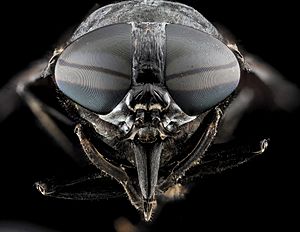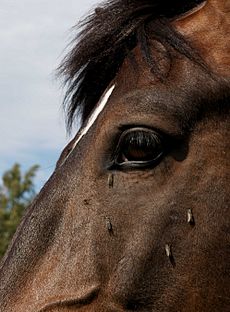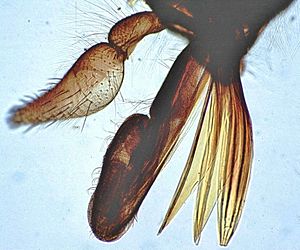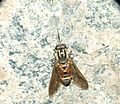Horse fly facts for kids
Quick facts for kids Horse fly |
|
|---|---|
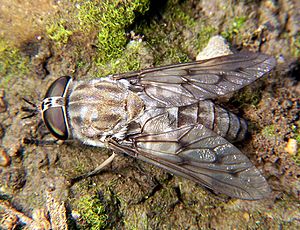 |
|
| Tabanus sulcifrons | |
| Scientific classification | |
| Kingdom: | |
| Phylum: | |
| Class: | |
| Order: | |
| Suborder: |
Brachycera
|
| Infraorder: |
Tabanomorpha
|
| Superfamily: |
Tabanoidea
|
| Family: |
Tabanidae
|
A horse fly is a type of insect. It belongs to the family Tabanidae. These flies can be as small as a housefly or as big as a bumblebee. Sometimes people call them "greenheaded monsters" because of their shiny, colorful eyes.
Male horse flies have eyes that touch at the top of their head. Female horse flies have eyes that are separate. Another nickname for them is "gad fly." This might be because they fly around a lot, or because their mouthparts look like a tool used for digging.
Contents
What Do Horse Flies Look Like?
Adult horse flies are large and strong insects. They have big compound eyes and short antennae. Their bodies are wide. Female horse flies have eyes that are far apart. Male horse flies have eyes that are almost touching. Their eyes are often bright and colorful when they are alive.
Their antennae have three parts and look pointed. Horse flies have short hairs on their head and body. Their front wings are clear or sometimes gray, brown, or patterned. They also have small, knob-like hindwings called halteres, which help them balance when flying.
Different Types of Horse Flies
Horse fly species can be medium to very large. Most are about 5 to 25 millimeters (0.2 to 1 inch) long. The biggest ones can have a wingspan of 60 millimeters (2.4 inches).
- Deer flies (genus Chrysops) are up to 10 millimeters (0.4 inches) long. They have yellow to black bodies with striped bellies. Their wings have dark patches.
- Horse flies (genus Tabanus) are bigger, up to 25 millimeters (1 inch) long. They are usually dark brown or black. Their eyes are dark and often look metallic.
- Yellow flies (genus Diachlorus) are shaped like deer flies. They have yellowish bodies and purplish-black eyes with a green shine.
Some horse flies, like those in the Pangoniinae group, have a very long proboscis. This is a tube-like mouthpart.
Horse Fly Larvae and Pupae
Horse fly larvae are long and shaped like cylinders. They have small heads and 12 body parts. Each body part has rings of bumpy growths called tubercles. They also have bands of short bristles.
The back end of a larva has a breathing tube. The pupa is the stage before the adult fly. You can see the shape of the adult's head and wings through the pupa. The pupa has seven body parts that can move. Its back end has spine-like bumps.
How Horse Flies Fly
Some horse flies, like deer flies, make a lot of noise when they fly. Others, like clegs, fly quietly and can bite without much warning. Horse flies are very good at flying. Some species can do amazing turns in the air, similar to fighter jets.
Horse flies might even be the fastest flying insects! A male Hybomitra hinei wrighti horse fly has been recorded flying up to 145 kilometers (90 miles) per hour when chasing a female.
Where Do Horse Flies Live?
Horse flies live all over the world. They are not found in very cold places like the North and South Poles. They are also missing from some islands, such as Greenland, Iceland, and Hawaii.
Different types of horse flies live in warm, cool, and tropical areas. They like moist places for laying their eggs. You can find them in many different habitats, from deserts to high mountain meadows. They live from sea level up to at least 3,300 meters (10,800 feet) high.
Horse Fly Biology and Life Cycle
What Do Horse Flies Eat?
Adult horse flies drink nectar from flowers and plant juices. Some are important pollinators for special flowers. Certain species in South Africa and Asia have very long proboscises. These help them reach nectar deep inside flowers with long, narrow tubes.
Both male and female horse flies drink nectar. However, most female horse flies also need a blood meal. They need blood to produce their eggs properly. To get blood, females bite animals, including humans. Male horse flies do not bite; they are harmless.
How Do Female Horse Flies Find Food?
A female horse fly needs about six days to digest her blood meal. After that, she needs to find another animal to bite. Horse flies seem to be attracted to animals that are moving, warm, or have a certain skin texture. They also like the carbon dioxide that animals breathe out.
They mostly choose large mammals like cattle, horses, camels, and deer. But some species will bite smaller mammals, birds, lizards, and even turtles. Because their bite is painful, animals often try to brush them off. This means a horse fly might have to bite many animals to get enough blood. This behavior can also spread diseases from one animal to another.
How Do Horse Flies Bite?
The female horse fly's mouthparts are made of six sharp, hard parts. These parts, along with a fleshy lower lip, form the proboscis. There are also two feelers on the sides.
When a horse fly lands on an animal, it grips the surface with its clawed feet. Then, it pushes its head down and uses its sharp mouthparts to cut into the skin. Some of these parts have saw-like edges. Muscles help them move side-to-side to make the wound bigger.
The fly injects saliva into the wound. This saliva contains a substance that stops the blood from clotting. The blood that flows out is then soaked up by another mouthpart that works like a sponge.
Why Horse Fly Bites Hurt
Horse fly bites can be painful for a day or more. The fly's saliva can cause allergic reactions. These might include urticaria (hives) or trouble breathing. Horse fly bites can make it unpleasant to be outdoors for humans. They can also reduce how much milk cows produce.
Horse flies are attracted to reflections from water, like from swimming pools. They prefer sunny places and usually avoid shaded areas like barns. They are not active at night.
Different horse fly species bite in different ways. Clegs fly quietly and often bite humans on the wrist or bare leg. Large Tabanus species make a loud buzzing sound. They fly low and bite ankles, legs, or the backs of knees. Chrysops flies a bit higher and bites the back of the neck. They have a high buzzing sound.
Some scientists think the stripes on zebras might help protect them from horse flies and tsetse flies. Zebras with closer stripes seem to attract fewer flies. The stripes on a zebra's legs are very fine. These are the parts of the body that other animals without stripes are most likely to get bitten on.
What to Do if a Horse Fly Bites You
Horse fly bites are painful for humans. Usually, a raised red bump appears around the bite. Other signs might include a rash, dizziness, weakness, wheezing, or swelling around the eyes or lips. Some people can have an allergic reaction.
If you get bitten, you should wash the bite area. Then, put a cold compress on it. Try not to scratch the wound. You can also put an antihistamine cream on it. In most cases, the pain and swelling go away in a few hours. But if the bite gets infected, you should ask a doctor for help.
Images for kids
-
Robert Hooke was amazed by the eyes of a "drone fly" in his book Micrographia (1665). This might be one of the first good pictures of a horse fly.
See also
 In Spanish: Tábanos para niños
In Spanish: Tábanos para niños


